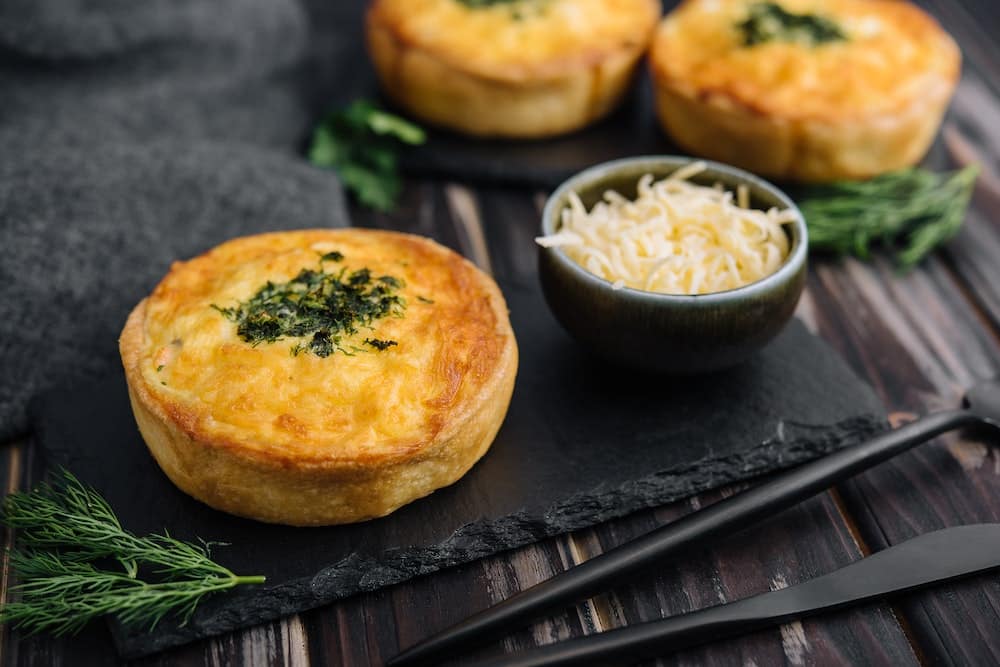Quiche – one of the most versatile dishes to grace our menus. Whether you’re a fan of the traditional quiche Lorraine, or you prefer to experiment with more creative fillings, the secret to the perfect quiche lies in the crust. It needs to be flaky, buttery and just the right amount of crispy to perfectly complement the rich, creamy filling. But how do you achieve that? It’s all about the techniques. You’ll be amazed at how a few simple tips and tricks can ensure your quiche is a gourmet delight every time. Let’s get started.
The Importance of the Pie Crust
The pie crust is the backbone of any quiche. A perfectly flaky crust can make or break your quiche experience. But just how do you achieve this culinary marvel? The secret lies in the ingredients and the method of preparation.
A lire aussi : How to make traditional irish soda bread?
When it comes to ingredients, be sure to use cold butter. This will ensure that your dough is crumbly and light, leading to a more flaky result. The proportion of butter to flour is also crucial. A good rule of thumb is to use one part butter to two parts flour.
Once you have your ingredients, the next step is to make the dough. The key here is to avoid overworking it. Overworking the dough can lead to gluten development, which will make your crust tough instead of flaky.
Sujet a lire : Egg-free cake recipes for allergies
When it comes to rolling out your dough, be sure to keep it thin. A thick crust will take longer to cook, which could lead to an undercooked base. Once rolled out, make sure to prick the base with a fork. This will prevent the dough from puffing up in the oven.
Achieving a Rich Quiche Filling
The filling is where you can let your culinary creativity shine. With a wide variety of options available, from cheese and vegetables to meats and seafood, the possibilities are endless. However, the base of your filling should always be a combination of eggs and cream.
The proportion of eggs to cream is vital. Too many eggs and your quiche will be more like a frittata; too much cream and it won’t set properly. A good rule of thumb is to use one part egg to two parts cream.
In terms of additions, cheese is a classic ingredient in quiche recipes. A sharp cheese like cheddar or Gruyere will add a nice contrast to the richness of the cream.
Once your filling is ready, it’s time to pour it into your pan. Be sure to leave a little room at the top as the filling will expand while it bakes.
Preparing Your Quiche for the Oven
Before your quiche can hit the oven, there are a few final steps to take. First of all, make sure your oven is properly preheated. A cold oven will cause your crust to become soggy and your filling to remain undercooked.
Another technique that ensures a perfectly flaky crust is blind baking. This involves pre-baking the crust before adding the filling. Not only does this give your crust a head start, but it also helps to avoid a soggy bottom.
To blind bake, line your dough with parchment paper and fill it with baking beans or dried rice. Bake it for about 15 minutes, then remove the parchment and beans and bake for about 5 more minutes until lightly golden.
Baking and Serving the Quiche
With your quiche now ready for the oven, it’s important to bake it at the right temperature. Too high and your crust will burn before your filling is cooked; too low and your filling will be done before your crust is crispy enough. A temperature of around 180-200°C (350-375°F) is usually about right.
The baking time will depend on the size of your quiche. A small quiche might take around 25-30 minutes, while a larger one could require up to 45 minutes. A good way to test if your quiche is done is to insert a knife into the center. If it comes out clean, your quiche is ready.
Once your quiche is done, allow it to cool in the pan for a few minutes. This will make it easier to remove and it will also give your quiche a chance to set, ensuring a firm, creamy texture when you cut into it.
And there you have it, the techniques to ensure a perfectly flaky gourmet quiche with a rich filling. Remember, the secret lies in the pie crust and the filling, but also in the baking method. Now, all that’s left is for you to start experimenting with your own quiche recipes. Happy baking!
Expert Tips for a Flawless Quiche Crust Recipe
Venturing towards a phenomenal quiche experience, your quiche crust recipe plays an instrumental role. To make a quiche that would make a French grandma proud, it’s best to stick to tried-and-tested techniques. Remember that the crust is not just a vessel for your quiche filling, but an integral part of the overall flavor and texture.
While we’ve mentioned the importance of cold butter and the ratio of butter to flour, another secret to an excellent pie crust is the inclusion of a tiny amount of sugar. It’s not enough to make the crust sweet, but it helps to balance the flavors and aids in browning.
Now, you might wonder, what’s the best way to combine these ingredients? Enter your trusty food processor. It does the job quickly and efficiently, ensuring your butter doesn’t melt from overhandling. Pulse until the mixture resembles coarse crumbs, then add ice cold water, a tablespoon at a time, just until the dough comes together.
Once your dough is formed, flatten it into a disk, wrap in plastic wrap, and let it chill in the fridge for at least an hour. This rest period allows the gluten to relax, ensuring a flaky crust. Never skip this step as it guarantees your pie crust to be firm and not shrink during baking.
When it’s time to roll out your dough, dust your surface with a bit of flour. Roll from the center outwards, ensuring an even thickness. Carefully fit your rolled dough into your pie pan or deep dish, avoiding any stretching as it can cause shrinking during baking.
Remember the blind baking technique described earlier? To do this, line your crust with parchment paper, fill with pie weights or dried beans, and bake. Pre-baking the crust ensures it won’t become soggy once the filling is added. A blind bake for about 10-15 minutes should do the trick – just until it’s lightly golden.
Adding Variety to Your Quiche Recipe
Once you’ve mastered the classic quiche Lorraine, you can start to get creative with your fillings. Perhaps add some sautéed spinach and feta for a Greek twist, or smoked salmon and dill for a Scandinavian spin. Just remember to keep the egg-to-cream ratio constant.
You might also consider adding some spices or herbs to your filling. A pinch of salt and pepper can go a long way to enhance the flavors. Fresh herbs like basil, thyme, or chives can add a burst of freshness. One tip, though, when adding ingredients that release water like mushrooms or tomatoes, be sure to sauté them first to remove excess moisture.
If you happen to be using a store-bought crust, you can still ensure a crispy, flaky result. Try brushing the crust with a little beaten egg before adding your filling. This creates a seal, preventing the crust from getting soggy.
Conclusion: The Art of Making a Perfectly Flaky Gourmet Quiche
In conclusion, mastering the art of making a gourmet quiche is not just about having a great quiche recipe. It’s about understanding the role and impact of each ingredient and technique. From the importance of a flaky pie crust to the perfect filling consistency, every detail matters.
So whether you’re sticking to the classic quiche Lorraine or inventing your own filling, remember to respect the pie crust-to-filling ratio, to blind bake your crust, and to bake your quiche at the right temperature for the right amount of time. Pay attention to the resting period and make sure to use cold butter for your crust.
Now that you’ve learned the secrets, it’s time to put them into practice. Roll out your dough, whip up your filling, and bake quiche that’s sure to impress. With a little time and patience, you’re well on your way to creating a masterpiece in your own kitchen. Happy baking indeed!





